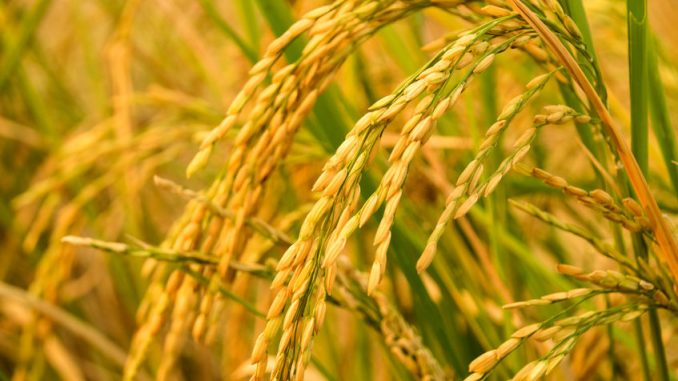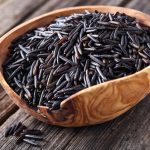
Golden Rice is one of the first varieties of rice (Oryza sativa) to be manufactured using genetic engineering or synthetic biology techniques. Using recombinant DNA technology, this special type of rice has been produced with higher levels of provitamin A (beta-carotene) than in those rice plants found in the wild. The intention is to meet a growing need for better nutrition in countries that rely on rice as a staple by providing more vitamin A in the diet.
Biofortification is seen as one route to improving the global nutritional status of many who are regarded as malnourished. The term biofortification just to be clear is the creation of plants that can make or accumulate micronutrients. That principle has been applied to an important staple of third-world and developing countries.
Rice is a global staple which has been grown for probably well over 10,000 years if not longer. It provides 80 per cent at least of the daily energy intake of 3 billion people (half the world’s population). It is also a source of vitamins and minerals but not provitamin A. There are other plants however which offer provitamin A in a the diet. A substantial amount of provitamin A is found in orange carrots and sweet potatoes.
Lack of vitamin A is viewed as a pervasive public health issue on a worldwide scale. The idea behind producing a biofortified rice which produced more provitamin A than usual was to offer a complementary, food-based solution which improved oral supplementation and a measure of diet diversification. By raising the opportunity of providing more vitamin A in the diet using a staple such as rice, it is thought that between 30 and 50 per cent of the estimated average requirement of the vitamin is achieved for women and especially children.
Vitamin A deficiency (VAD) includes symptoms such as night blindness, a raised susceptibility to infections and cancers, prevalence of anaemia which is a lack or red blood cells and haemoglobin and cardiovascular disease. A lack of vitamin A at critical stages of development in children can lead to irreversible blindness.
The development of Golden Rice is not without considerable controversy. Firstly, it is a genetically modified organism (GMO). GMOS are generally banned in most countries because of the issues surrounding their potential to enter the more general population and cause damage to the environment. Whilst that is a simplistic view and perhaps naively put it has concerned many environmental groups who are strongly opposed to such developments.
A Golden Rice Humanitarian board was created back in 1982 so that the products of the project would be directed towards global development. This would mean free distribution of the rice to farmers in the key rice producing countries.
The release of Golden Rice for common cultivation is perceived as sustainable. Here the farmer can save seed and grow on for the next season without resorting to continued investment on a yearly basis.
Technology
The Golden Rice project began in 1982 when Ingo Potrykus (Professor Emeritus) at the Institute of Plant Sciences of the Swiss Federal Institute of Technology (ETH), Zurich in Switzerland collaborated with Peter Beyer, Professor at the Centre for Applied Biosciences at the University of Freiburg in Germany. The whole project was funded by the Rockefeller Foundation, the Swiss Federal Institute of Technology and the crop protection company, Syngenta.
The objective was to genetically engineer rice plants to produce more carotenoids. The target was to generate more beta-carotene (provitamin A) in the endosperm. This is the edible portion of a rice grain.
To achieve this aim of producing more provitamin A, required inserting two key genes into the rice genome which would complete the biosynthetic pathway.
The first gene used is the daffodil (Narcissus pseudonarcissus) gene that encodes phytoene synthase (psy) to produce ‘Golden Rice 1’. Phytoene synthase is a transferase enzyme that is critical in the production of carotenoids. It catalyses the conversion of geranylgeranyl pyrophosphate to phytoene.
The other was the gene from Erwinia uredovora, a soil bacteria which codes for lycopene cyclase or carotene desaturase (crtI) (Ye et al., 2000). The two additional enzymes could produce carotenoids in the rice grain’s endopserm.
Both genes were transformed into the nuclear genome of the rice. To obtain expression of the genes only in the endosperm, they were placed under the control of the promoter which only operates in that part of the rice grain. The use of the bacterial crt1 gene was highly significant because it catalyses a number of steps in carotenoid biosynthesis. In plants a number of enzymes would normally be needed to achieve the same level of synthesis.
An exogenous lyc gene was added as a transit peptide sequence which was targeted to a plastid, where geranylgeranyl diphosphate production occurred. The end product of the engineered pathway was actually lycopene which is red as in tomatoes. It would have produced red rice instead. The rice endosperm has an endogenous enzyme catalysed process of converting lycopene to beta-carotene which gives it the golden yellow colour.
The new variant, the original was designated SGR1. Under glass growing conditions the amount of carotenoids produced in the endosperm was 1.6 micrograms/gram.
However, the daffodil gene insertion proved to be a limiting step in beta-carotene production. A new variant, ‘Golden Rice 2’ used the psy gene from maize that overcame this limiting step (Paine et al., 2005). They observed a 23-fold increase in total carotenoid accumulation compared to the first Golden Rice produced.
Regulatory Situation For Golden Rice
The US Food and Drug Administration (FDA) has paid considerable attention to Golden Rice. The rice variety under food safety examination is designated GR2E Golden Rice. The rice had already received approval on safety and nutritional grounds by two other bodies – the Food Standards Australia New Zealand (FSANZ) and Health Canada in February and March of 2018.
In May 30th, 2018, the FDA completed their third positive food safety evaluation. The USA’s national regulatory agency agreed with the International Rice Research Institute (IRRI) that this rice variety was safe and provided a supplemental level of vitamin A.
These three national regulatory agencies perform their assessments according to the concepts and principles developed over more than two decades by key international organizations. These include the World Health Organization (WHO), the Food and Agriculture Organization (FAO) of the United Nations, the Organisation for Economic Co-operation and Development (OECD) and the Codex Alimentarius Commission.
When a new variety such as Golden Rice receives the necessary national approval, it is possible then to start planting it as part of a deployment program to the target communities that will derive most benefit from the plant.
The IRRI Director General Matthew Morell was quoted back in 2018 as stating:-
“Each regulatory application that Golden Rice completes with national regulatory agencies takes us one step closer to bringing Golden Rice to the people who need it the most. The rigorous safety standards observed by the FDA and other agencies provide a model for decision-making in all countries wishing to reap the benefits of Golden Rice.” (IRRI, 2018; FDA, 2018).
References
FDA (2018) Letter (pdf)
IRRI (2018) Press release
Paine, J.A., Shipton, C.A., Chaggar, S., Howells, R.M., Kennedy, M.J., Vernon, G., Wright, S.Y., Hinchliffe, E., Adams, J.L., Silverstone, A.L. and Drake, R., 2005. Improving the nutritional value of Golden Rice through increased pro-vitamin A content. Nature Biotechnology, 23(4), p.482. (Article)
Ye, X. et al. (2000) Engineering the provitamin A (β-carotene) biosynthetic pathway into (carotenoid-free) rice endosperm. Science 287, pp. 303–305 (Article)

Leave a Reply